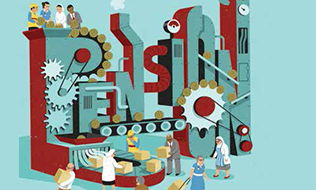

Much like the Greek philosopher Diogenes of Sinope and his search for an honest man, pension plan stakeholders have been seeking a sustainable plan design for years. The many designs plan sponsors have tried have typically functioned effectively only in a limited set of conditions. The problem is the world keeps changing. Recognizing it’s impossible to accurately predict the future, what should plan sponsors do?
Let’s start by hypothesizing a definition of a sustainable pension plan as one that balances price and benefits in a manner that’s satisfactory for all stakeholders over the lifetime of the program. It’s easy to say but what does it mean?
In considering the issue, it’s important to recognize that pension plans can only pay out benefits from funds accumulated through actual contributions and investment income. While assumptions can affect the timing of benefit payments and required contributions, they don’t generate real dollars and, in the long run, that equality must hold. At the same time, plan stakeholders shouldn’t assume they can reliably predict the future.
Read: 92% of pension funds plan to upgrade governance: report
Taken together, those two facts mean a sustainable pension plan has to be able to adapt to future actual outcomes, even when they differ substantially from original expectations, while maintaining benefits and contributions at affordable levels.
What’s key is to recognize that achieving a sustainable pension plan design is more about process than a particular model or benefit formula.
The following four elements are ingredients for developing a sustainable pension plan:
1. Objectives for the plan should be clear. Plan stakeholders should be clear about what they want to achieve in terms of benefits, contributions, resiliency and what their level of tolerance is.
2. All strategies should be in alignment with the objectives. That requires ensuring actions, in both good and bad times, are directed towards achieving the stated objectives. For example, assuming a benefit level that’s greater than what’s affordable through contributions within the risk tolerance of the stakeholders wouldn’t be an aligned action.
3. The plan goals and the ability to meet them should be transparent to all stakeholders. That includes outlining the consequences if a particular outcome implies further action. What happens if things go badly? Who pays more or receives less and how will that be determined?
4. The governance model should be such that there’s a high level of risk management applied to the operations so that appropriate actions are taken on a timely basis to drive the plan towards its objectives. That can be done through the application of a combination of risk prevention and management, as well as rational financial responses to unexpected variations.
Plans that adopt such an approach are more likely to succeed than those that rely only on a subset of potential strategies or wait for a crisis before acting.
Read: How Harry Rosen improved pension plan outcomes
Stakeholders should be comfortable that their plan can withstand significant financial stress. Relying solely on funding levels at the last valuation, last year’s investment returns, next year’s results or future contributors’ ability and willingness to pay is simply not enough given the range of potential outcomes.
Mel Bartlett is managing partner of retirement solutions for Morneau Shepell’s west region. Conrad Ferguson is a partner at Morneau Shepell’s Atlantic office.
Get a PDF of this article.
